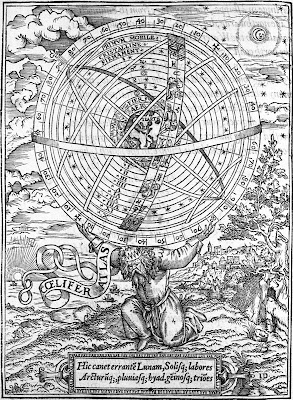Because the Atlas Shrugged movie came out recently I thought it would be fun to post a week of images of Atlas by various artists from history.
Nationality: English
Creation Date: 1559
Media: Engraving ink on paper (?)
Location: London, UK
This engraving is unusual because instead of depicting Atlas supporting the heavens and earth he is shown supporting an armillary sphere--a model of the earth and heavens. This image was the frontispiece for an English scientific text called The Cosmographicall Glasse from 1559 and this image reflects many ideas about the cosmos that were held during the Renaissance(1)--a time when scientific observation and religious belief were often blended.
 I suspect that the text "primum mobile" refers to God as the "first cause" and that the text on the next layer, "cristalline firmament," refers to the substance known as "the ether" which was believed to fill the space beyond the terrestrial plane. According to Christian mythology, this was the location of heaven. (2) Next comes fire and air, then "ye earth" (here shortened to "yearth") and water reside at the center. It is also noteworthy that there are ten rings which separate the earth from the heavens, which may be an allusion to the ten-ringed worlds of Dante's Divine Comedy.
I suspect that the text "primum mobile" refers to God as the "first cause" and that the text on the next layer, "cristalline firmament," refers to the substance known as "the ether" which was believed to fill the space beyond the terrestrial plane. According to Christian mythology, this was the location of heaven. (2) Next comes fire and air, then "ye earth" (here shortened to "yearth") and water reside at the center. It is also noteworthy that there are ten rings which separate the earth from the heavens, which may be an allusion to the ten-ringed worlds of Dante's Divine Comedy.Atlas' ribbon-like label reads "Atlas supporting the heavens," and strangely Atlas is crowned. I think this comes from his mythology because in The Aeneid he is described as "with piny forests crown'd" although I'm sure that refers to forests held above his head. Perhaps he is made out to be a king with his castle in the background or perhaps kings were seen as Atlas-like.
I am told that the Latin text at the bottom refers to the following lines from The Aeneid:
His golden lyre, and sung what ancient Atlas taught:
The various labors of the wand'ring moon,
And whence proceed th' eclipses of the sun;
Th' original of men and beasts; and whence
The rains arise, and fires their warmth dispense,
And fix'd and erring stars dispose their influence...
However, when I used Google Translate to decipher the text, the result was something like, "This will sound, the wandering moon, [the sun?], the labors of the Pleiades; [rain?]; hyades...[?]" My guess is that this text is intended to say something to the effect of "this book explains the movements of the sun, moon, stars and weather" while referencing The Aeneid. The Pleiades were a group of women that were thought to flea as Orion approached them which I presume is an explanation of the rotation of the stars since both these mythological figures are represented in the night sky. Although it's strange to think of the stars as having anything to do with the weather, because the Greeks believed the setting of the Hyades star cluster brought rain it makes sense that a classically-informed Renaissance scientist might conclude that a text on the stars would have meteorological ramifications.
1. The statements here come from recollections of the art history classes I took many years ago. If the reader finds an error in these statements, corrections are welcome.
2. I remember reading that belief in the existence of the ether persisted even into the 20th century until it was finally disproved at what is now Case Western Reserve University in Cleveland, Ohio. It's also my understanding that this discovery paved the way for relativity.

No comments:
Post a Comment